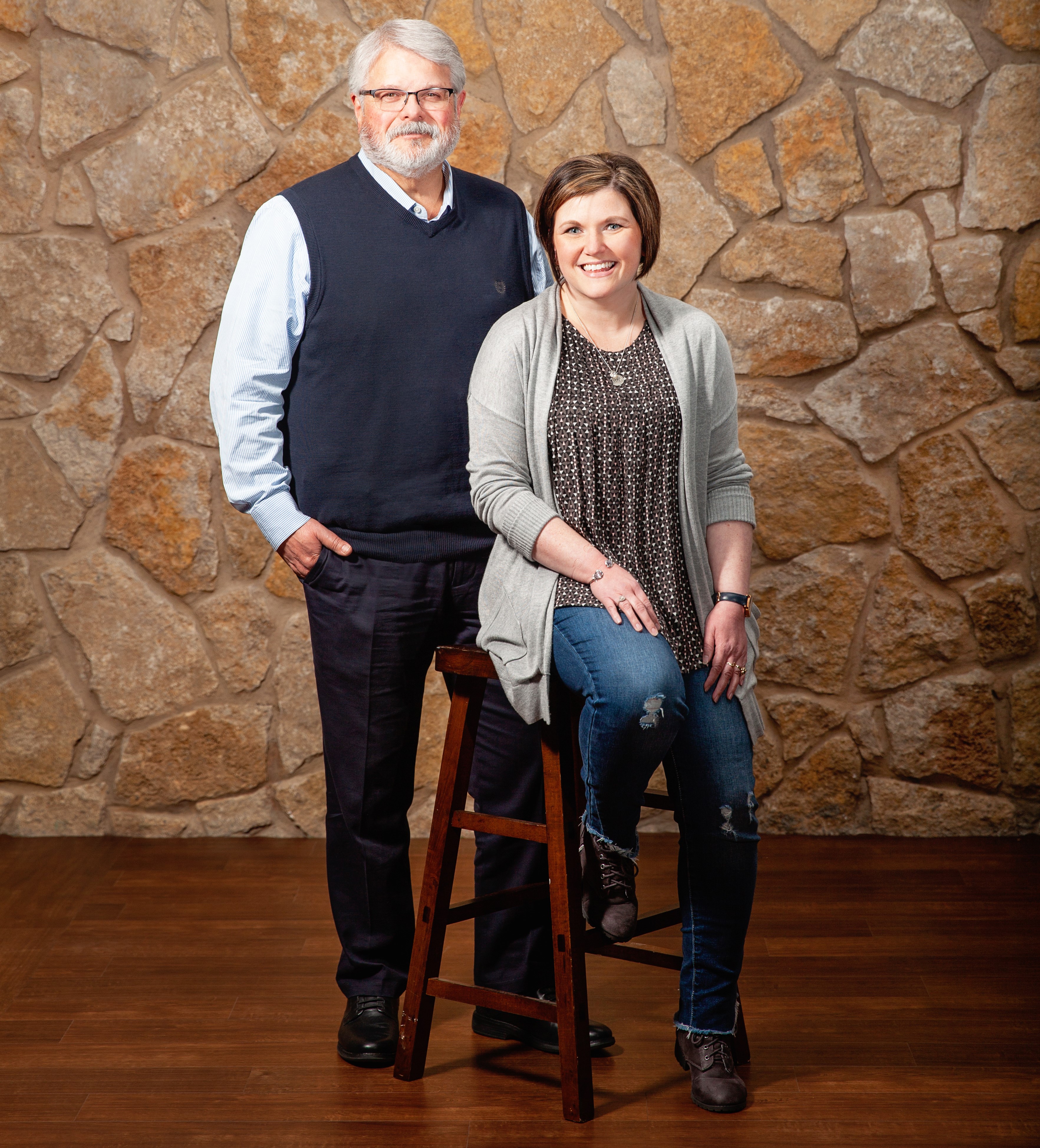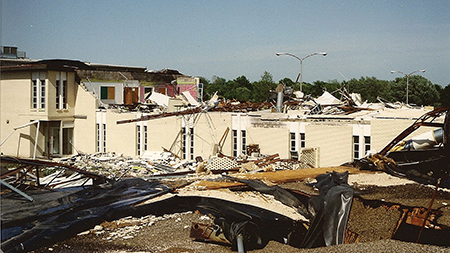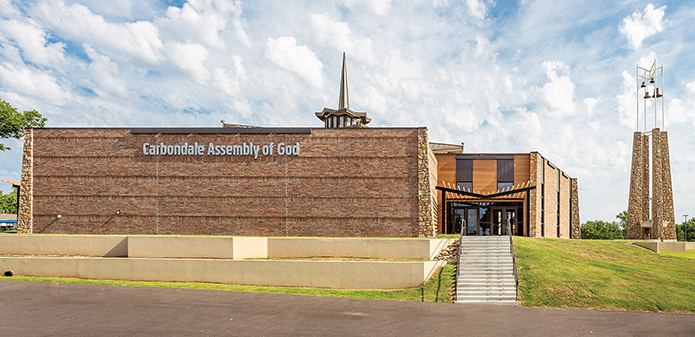
When a tornado destroyed their church, the father-daughter pastor team of Phil and Sarah Taylor enlisted a pastor’s son and second-generation church builder to help pick up the pieces.
By RaeAnn Slaybaugh
![]() When a devastating tornado touched ground in Tulsa, Oklahoma, on May 3, 1999, Phil Taylor, his wife Paula, and their daughter Rebekah were at home just 50 yards away from Carbondale Assembly of God, where Phil is senior pastor. The couple’s other daughter, Sarah (now associate pastor at the church), was away at college.
When a devastating tornado touched ground in Tulsa, Oklahoma, on May 3, 1999, Phil Taylor, his wife Paula, and their daughter Rebekah were at home just 50 yards away from Carbondale Assembly of God, where Phil is senior pastor. The couple’s other daughter, Sarah (now associate pastor at the church), was away at college.
“It sounded like a train rolling through — wind howling, and like all the air got sucked out of the room,” Phil recalled. “We were lying in the hallway, just praying.”
There was the sound of breaking glass, a huge roar and a loud “whoosh.” Finally, silence.
In that moment, the Taylors’ staff-member cousins, as well as the youth pastor and his wife, were top of mind. All were in the church basement when the tornado hit.
As Phil made his way out the back door, he and the youth pastor (who was making his way to the Taylors’ house) had a hard time seeing each other with all the debris between them. At first, the youth pastor thought the house had been leveled.
Miraculously, however, everyone in both locations was OK. They all gathered at the house. After midnight, they ventured out to survey the damage to the church.
“It was like a gut punch,” Phil said.

Much more than a building
On that day, the Taylors experienced what’s surely among any church leader’s worst nightmares: the loss of a church. What’s more, their relationship with Carbondale Assembly began more than 30 years before, in 1967, when a young Phil moved to Tulsa with his parents.
He grew up in the church. In fact, Phil even met Paula in the youth group there. They married in 1975 and began traveling and preaching as youth pastors.
That same year, the long-time pastor at Carbondale Assembly retired, and the new pastor hired Phil and Paula to be youth leaders. Phil was still in school at nearby Oral Roberts University.
A few years later, after graduation, he became the associate pastor.
In 1985, that pastor retired, and Phil took on the senior pastor role.
Their daughter Sarah also grew up at Carbondale Assembly.
“I’m a classic youth camp story,” she said. “I felt a call to the ministry at 17.”
So, she was devastated after receiving a call at college and learning that the church was gone.
At that point, Sarah hadn’t yet received a calling towards pastoral work. “I think it’s probably because I didn’t have a lot of female examples in those roles,” she explained.
After graduating, she spent 11 years as a missionary with the Assemblies of God. Throughout her time away, she stayed keenly aware of the ministry happenings in her home church. So, when the offer to become the associate pastor at Carbondale Assembly arose in 2013, she said “it felt really right.”
Sarah knew, for example, that the church had been considering renovation prior to the tornado.
“God was saying, ‘Now’s the time,’” she said.
In the aftermath
The full extent of the tornado’s damage came into focus over the next few days.
The upper floor of a two-story building connecting the sanctuary and the gym was completely gone. The gym also took a structural hit; the walls on one end had to be propped up. Both the east and west wings of the sanctuary were heavily damaged with their roofs missing.
The sanctuary was also damaged, but structurally sound.
“What’s remarkable about that is [our cousins and the youth pastors] were actually in the basement directly below the sanctuary when the tornado hit,” Sarah said. “It was the least-damaged piece of the whole building. If they’d been anywhere else, it could’ve been a different story.”
Phil agreed: “We felt like the Lord had his hand on it.”
As a testament to that belief, Billy Joe Daugherty of Tulsa’s Victory Church came to the Taylors’ home the next day to offer the Victory Bible Institute (VBI) building for worship services and small groups. That morning, the insurance company had determined Carbondale might be without a facility for two years — but Billy Joe didn’t waver. “His answer was, ‘Well, we don’t plan to go anywhere. So, you can use the building as long as you need it,’” Phil recalled.
By the following evening, Carbondale was hosting worship services in the VBI building. Chairs, a sound system, a keyboard and drums were all in place, as Daugherty felt strongly that the congregation needed to hear from Phil.
For 20 months, the church met in that building. Billy Joe never accepted payment.

Refocus, rebuild
Phil then turned his attention to rebuilding the church facilities. He called Larry Johnson, who was on staff at nearby Rhema Bible Church and had — like Phil — grown up in Carbondale Assembly. Larry recommended his friend Charlie Daniels, who’d built Rhema’s 5,000-seat sanctuary.
Larry brought Charlie to Carbondale to have a look. It’s a day Charlie remembers well.
“Man, it was a mess,” he recalled. “All the block walls had been lifted up and set back down. So, there was no fixing any of it — just scraps.” Floors would need to be torn up and dirt taken out of the ground. Everything would need to be redone.

Soon after, Larry facilitated a meeting between Phil and Charlie. Having never built a building or raised funds for a large project, Phil admitted he was flying blind.
“But Charlie met with us and said, ‘Look, I can help you find an architect. I’ll get the subcontractors, and we’ll do this together,’” he recalled. “He came alongside us for every aspect.”
At the time, Charlie had done other church rebuilds, but nothing so extensive. Even so, Phil said he knew Charlie was the right fit for a few key reasons. First, there was his long-time friend’s recommendation. Second, he appreciated the fact that Charlie is “a preacher’s kid.” Indeed, Charlie’s father was a minister — but also a church builder.
“So, even as a kid, I was learning to build and working with him,” Charlie said. “He had a really good, strong work ethic that all my brothers and sisters and I inherited. So, working with Phil was second nature. It was the right fit at the right time.”
Phil said he recalls Charlie being onsite at the church nearly every day from that point on.
Blessed beyond belief
Though a large rebuild project was underway, Phil and his team also needed to focus on sustaining church operations in the interim.
“We just said, ‘All right, let’s figure out to be the church without walls!’” he said. “I kept saying to the congregation, ‘Look, the building is just a tool for us to use to build God’s kingdom and to reach people. But in the meantime, what’s He calling us to be in Tulsa in this facility?’”

Sunday school classes were held in one large room, broken up with dividers. To sustain community outreach efforts, church members took bottled water to people on the streets. A yard sign in front of the VBI building read: Carbondale Assembly Meets Here.
The result was even better than Phil anticipated: the church body actually grew during its time without a permanent facility. By spring 1999, rising attendance dictated an expansion of the permanent facility. More classrooms, a youth center, a children’s church, a kitchen, and offices were added. Previously, staffed had worked out of a house.
Per the new design, square footage nearly doubled. Even the parking lot was redone.
“It was everything we’d already thought we ought to do, plus some,” Phil said.
Of course, vast expansion comes with a commensurate price tag. When the estimate for the project came it at $4.5 million — $1.5 million more than the insurance settlement — Phil knew he had a big fundraising goal ahead of him. With $300,000 cash in the bank, the total amount to be raised exceeded $1 million.
As the builder, Charlie said he knew the church could get there if they all worked together. To that end, Phil introduced him to the congregation. They prayed over him that day.
“I remember it distinctly,” Charlie said. “I felt like our hearts were knit together at that time, and I ended up with a real heart for Phil and his congregation. I’ve had it ever since.”
Week by week, Phil gave the congregation progress reports and asked them to pray for Charlie, for good weather, for the contractors and so on.
He also met with several stewardship companies; they all said the fundraising goal was impossible. “They told me, ‘You can’t expect a congregation to double their giving in 12 months,’” Phil remembered. “But we just felt like God put it in our hearts to do this [project] on a cash basis.”
Plus, he added, the church was highly motivated to give … for obvious reasons.
“I thought, Have you seen our property? There’s a fence around it, and skunks are living in the floor vents!” he laughed. “Every time we drove by, we’d think, Oh man, we’ve got to get that church rebuilt.”
Sarah agreed: “He didn’t have to present the vision, because everyone could see it.”
Undeterred, Phil taught on giving for about a month. He fasted and prayed. He bought 300 copies of How to be Happy Giving Your Money Away by E.M. Clark and gave a copy to every family in the church, believing it would challenge their thoughts on giving. The author even attended a banquet with church members and preached on a Sunday morning. That day, Carbondale received $100,000 in a cash offering and pledges for $1.1 million to be given over the next 12 months.
The church moved into its new buildings debt-free.
The next phase takes shape
Even with all the new space, retaining some of the church’s past was a priority for Phil.
“The history is important to me because I’ve been here so long,” he said. “I knew some of the former pastors, and I’ll probably be the last pastor who can say that.”
The original hexagonal-shaped sanctuary, built in 1967, still stands at the center of the campus. Inside, the sanctuary was rebuilt largely as designed more than 30 years ago. A glass ceiling fixture in the foyer — somehow undamaged — was reinstalled. Outside, the original bell tower was repaired. The exterior look of the buildings didn’t change much.
Carbondale Assembly operated for more than 15 years in its new facilities. As building needs arose on a smaller scale (repairing a step or knocking out a wall, for example), Phil called Charlie for a recommendation. Often, Charlie picked up the phone himself and called the right repairman or contractor.
“It wasn’t about the business; it was about the Kingdom,” Phil said. “Charlie is a guy who loves Jesus and wants to rebuild. He has to make a living, but he was honest with us and always available.”
For Charlie’s part, he said he believes relationships and buildings should be more relational than contractual. “We all have to have contracts; the banks make us do them,” Charlie said. “But if you have to go back and look at your contracts, you really don’t have a good relationship.”
New beginnings, again
In spring 2017, Phil knew a remodel was in order. And this time, his daughter Sarah — serving as associate pastor — would be right beside him, deeply involved in the day-to-day planning.
“The staff had met and contacted some other people about staging and those kinds of changes, but whenever we really got down into it, it felt right to call Charlie because he knows us; he gets us,” she explained. “And he’s able to connect us to all the right people to deliver what we’re trying to do, which has always brought real peace of mind.”
This time around, the project’s objectives would be different.
QUICK FACTS ABOUT CARBONDALE ASSEMBLY OF GOD
Year established: 1934
Location: Tulsa, Oklahoma
Staff (full- and part-time): 10 / 5
Combined weekly attendance: 625
2020 budget: $2 million+
“In 2000, we mostly put the church back together and expanded,” Sarah recalled. “So, there hadn’t really been a true remodel of that space in, like, 30 years. And it was definitely time to upgrade the sanctuary.”
Phil agreed: “We wanted to build something that facilitates growth. So, we feel that everything we put into this remodel lends itself to the church of the future.”
Together, Phil and Sarah recognized the need for more meeting and fellowship space, since the lobby was packed in between worship services. Additional connection spaces (including a coffee shop) were added.
Behind the stage, a media and A/V area was built. Here, the church houses its recording and audio equipment. Additionally, lighting, sound and video systems were upgraded to the point where, as Phil put it, “the youth can get in there and just go crazy.”
The church even integrated environmental projection. “I thought, That’s the modern version of stained glass,” Phil recalled. “I knew we could tell the story of the gospel with pictures on the wall.” This level of technology is a rarity for even the most forward-thinking churches, let alone a facility that continues to prioritize the church’s history aesthetically.
Yet, in this same sanctuary and foyer, the wood on the ceiling and walls — which harkens back to the original 1967 design — was retained and blended into the new design. The stone and lighting elements that have always created a sacred, worshipful environment are still there. Circa-2000 building additions around the sanctuary were improved, but still kept with how they looked before.
With the remodel finished in time for Easter services in 2018, this approach and its outcome reflects a guiding principle held by Carbondale Assembly and Charlie Daniels alike: building legacies for the continuation of Kingdom-building. So, it’s no surprise that this father-daughter pastor team found just what they needed in a pastor’s son who followed in his father’s church builder footsteps.
“The fact that he understood preachers and what’s important to people in a church was a big plus for us,” Phil said. “At this season of my life, I want there to be respect for and an acknowledgement of the history of what’s come before us. But I also don’t want our facility to grow outdated or out of touch, or to lose relevance in the facility itself.”
Focus on the future
At 64, Phil emphasizes that any future building projects aren’t for him — they’re for the generation to come. He’s aware that younger staff members might want to do away with the 1960s-era wood and fixtures at some point.
“But whatever we do with the design, we have to continue to reach people and minister to those who are hurting,” he said. “The urgency is different in a remodel versus a rebuild; but from a spiritual, emotional sense, it’s the same.”
Case in point: the church is already feeling the need for more children’s space, and its Wednesday night program draws more teenagers and kids than it can comfortably accommodate. Both are good problems to have, but it means further expansion is likely.
“If that’s what’s needed, then we know who to call,” Phil said.
Sarah agrees: “Who knows, we might be calling Charlie Daniels again sooner rather than later.”


